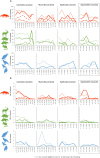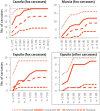Understanding potential implications for non-trophic parasite transmission based on vertebrate behavior at mesocarnivore carcass sites
- PMID: 34176034
- PMCID: PMC8235911
- DOI: 10.1007/s11259-021-09806-2
Understanding potential implications for non-trophic parasite transmission based on vertebrate behavior at mesocarnivore carcass sites
Abstract
High infection risk is often associated with aggregations of animals around attractive resources. Here, we explore the behavior of potential hosts of non-trophically transmitted parasites at mesocarnivore carcass sites. We used videos recorded by camera traps at 56 red fox (Vulpes vulpes) carcasses and 10 carcasses of other wild carnivore species in three areas of southeastern Spain. Scavenging species, especially wild canids, mustelids and viverrids, showed more frequent rubbing behavior at carcass sites than non-scavenging and domestic species, suggesting that they could be exposed to a higher potential infection risk. The red fox was the species that most frequently contacted carcasses and marked and rubbed carcass sites. Foxes contacted heterospecific carcasses more frequently and earlier than conspecific ones and, when close contact occurred, it was more likely to be observed at heterospecific carcasses. This suggests that foxes avoid contact with the type of carcass and time period that have the greatest risk as a source of parasites. Overall, non-trophic behaviors of higher infection risk were mainly associated with visitor-carcass contact and visitor contact with feces and urine, rather than direct contact between visitors. Moreover, contact events between scavengers and carnivore carcasses were far more frequent than consumption events, which suggests that scavenger behavior is more constrained by the risk of acquiring meat-borne parasites than non-trophically transmitted parasites. This study contributes to filling key gaps in understanding the role of carrion in the landscape of disgust, which may be especially relevant in the current global context of emerging and re-emerging pathogens.
Keywords: Carnivore; Carrion; Non-trophically transmitted parasites; Sarcoptes scabiei; Scavenger; Wildlife.
© 2021. The Author(s).
Conflict of interest statement
None.
Figures



Similar articles
-
Smart carnivores think twice: Red fox delays scavenging on conspecific carcasses to reduce parasite risk.Appl Anim Behav Sci. 2021 Oct;243:105462. doi: 10.1016/j.applanim.2021.105462. Epub 2021 Sep 25. Appl Anim Behav Sci. 2021. PMID: 34602687 Free PMC article.
-
Avoidance of carnivore carcasses by vertebrate scavengers enables colonization by a diverse community of carrion insects.PLoS One. 2019 Aug 29;14(8):e0221890. doi: 10.1371/journal.pone.0221890. eCollection 2019. PLoS One. 2019. PMID: 31465519 Free PMC article.
-
Carnivore carcasses are avoided by carnivores.J Anim Ecol. 2017 Sep;86(5):1179-1191. doi: 10.1111/1365-2656.12714. Epub 2017 Jul 17. J Anim Ecol. 2017. PMID: 28609555 Review.
-
How does a carnivore guild utilise a substantial but unpredictable anthropogenic food source? Scavenging on hunter-shot ungulate carcasses by wild dogs/dingoes, red foxes and feral cats in south-eastern Australia revealed by camera traps.PLoS One. 2014 Jun 11;9(2):e97937. doi: 10.1371/journal.pone.0097937. eCollection 2014. PLoS One. 2014. PMID: 24918425 Free PMC article.
-
Navigating parasite webs and parasite flow: emerging and re-emerging parasitic zoonoses of wildlife origin.Int J Parasitol. 2005 Oct;35(11-12):1279-94. doi: 10.1016/j.ijpara.2005.07.003. Int J Parasitol. 2005. PMID: 16168994 Review.
Cited by
-
Top-predator carrion is scary: Fight-and-flight responses of wild boars to wolf carcasses.Ecol Evol. 2023 Apr 5;13(4):e9911. doi: 10.1002/ece3.9911. eCollection 2023 Apr. Ecol Evol. 2023. PMID: 37033396 Free PMC article.
-
Taking cues from ecological and evolutionary theories to expand the landscape of disgust.Proc Biol Sci. 2024 Dec;291(2036):20241919. doi: 10.1098/rspb.2024.1919. Epub 2024 Dec 4. Proc Biol Sci. 2024. PMID: 39626751 Free PMC article. Review.
-
Wolf Is Back: A Novel Sensitive Sentinel Rejoins the Trichinella Cycle in the Western Alps.Vet Sci. 2023 Mar 9;10(3):206. doi: 10.3390/vetsci10030206. Vet Sci. 2023. PMID: 36977245 Free PMC article.
-
Understanding the distribution and fine-scale habitat selection of mesocarnivores along a habitat quality gradient in western Himalaya.PeerJ. 2022 Sep 16;10:e13993. doi: 10.7717/peerj.13993. eCollection 2022. PeerJ. 2022. PMID: 36132214 Free PMC article.
-
Newlavirus, a Novel, Highly Prevalent, and Highly Diverse Protoparvovirus of Foxes (Vulpes spp.).Viruses. 2021 Sep 30;13(10):1969. doi: 10.3390/v13101969. Viruses. 2021. PMID: 34696399 Free PMC article.
References
-
- Altizer S, Nunn CL, Thrall PH, Gittleman JL, Antonovics J, Cunningham AA, Dobson AP, Ezenwa V, Jones KE, Pedersen AB, Poss M, Pullian JRC. Social organization and parasite risk in mammals: integrating theory and empirical studies. Annu Rev Ecol Evol Syst. 2003;34:517–547. doi: 10.1146/annurev.ecolsys.34.030102.151725. - DOI
MeSH terms
Grants and funding
LinkOut - more resources
Full Text Sources

